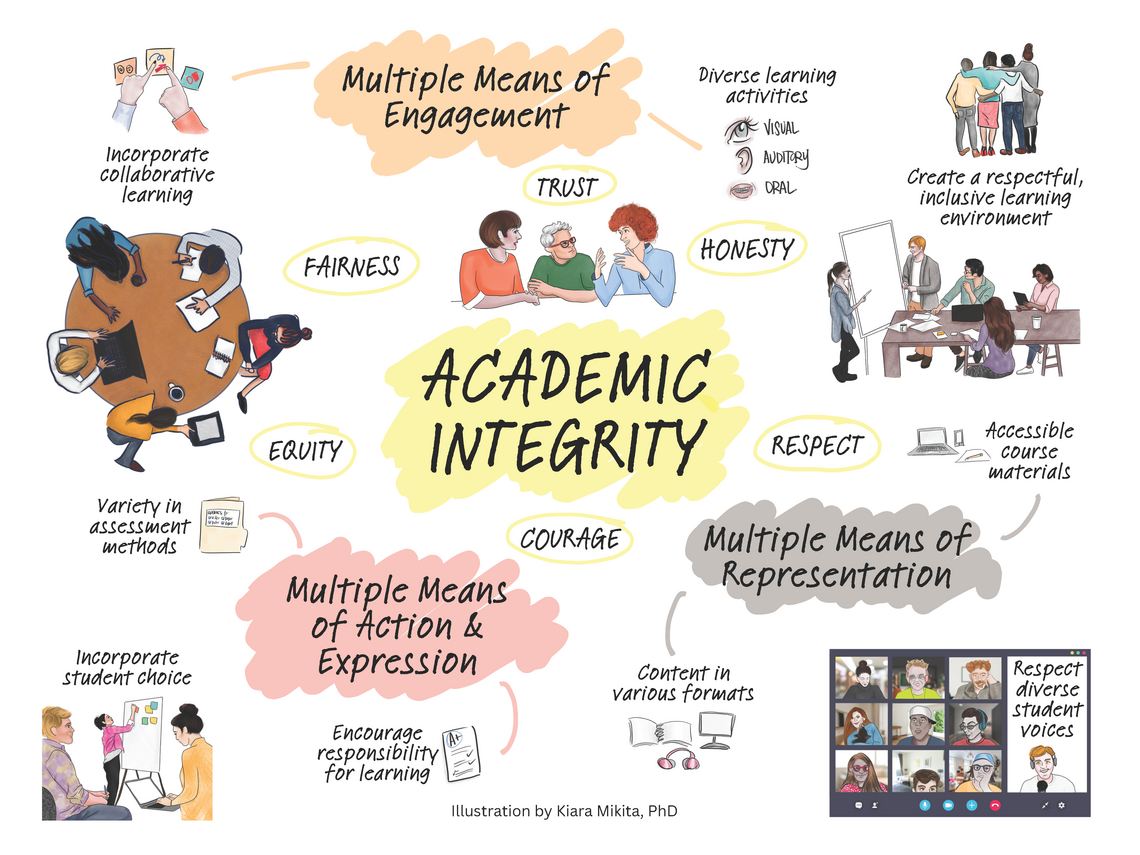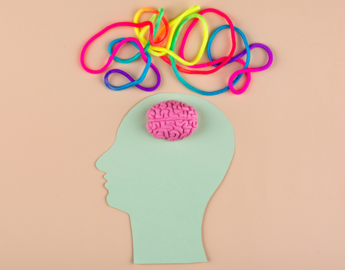Lesson overview
Universal Design for Learning (UDL) is a framework that highlights successful learning through the flexibility and participation of all students. The UDL framework is grounded in three principles: multiple means of engagement, multiple means of representation, and multiple means of action and expression (CAST, 2025).

The fundamental values of academic integrity – fairness, honesty, trust, respect, responsibility and courage – underscore the importance of ethical behavior in education (ICAI, 2021). When intertwined intentionally, both the framework and fundamental values support learning environments where all students can excel through inclusive and ethical learning. In this section, we will explore the three key principles of UDL and their correlation with promoting academic integrity’s core values.
Lesson checklist
- Explore the fundamental values of academic integrity
- Reflect on how these fundamental values can be supported through UDL
Multiple Means of Engagement and the fundamental values of academic integrity
Key Idea: UDL promotes the engagement of students through various strategies and activities aligned with their interests and abilities, fostering honesty and trust within the learning community.
Engaging students through diverse learning methods, such as collaborative projects, discussions and hands-on activities, not only accommodates their varied learning preferences but also encourages honest and open interactions.
In such an environment, students are more likely to trust their peers and instructors, as they recognize that their contributions are valued. This trust reinforces the principle of honesty in academic discourse, as students feel safe sharing their opinions and ideas. Additionally, it nurtures respect for diverse viewpoints and backgrounds, creating a respectful and inclusive learning community.
- In-person: In face-to-face classes, instructors can encourage open discussions, group projects and real-world applications of concepts. These methods not only cater to diverse learning preferences but also promote honest and trusting interactions among students
- Online: In online courses, educators can use discussion forums, digital collaboration tools and multimedia content to keep students engaged. These approaches create an inclusive and respectful virtual learning community, where students feel valued and trusted.
Activity: Guiding questions
- How can the principle of Multiple Means of Engagement be incorporated in your course to support the core values of academic integrity, particularly honesty and trust, among students?
- What diverse engagement strategies, such as collaborative projects and discussions, can be implemented to enhance students’ respect for diverse viewpoints and backgrounds?
- What specific activities can be designed that align with students’ interests and abilities while also promoting ethical behavior and trust within the learning space?
- How can an inclusive learning environment be created that fosters open and honest interactions among students, reinforcing the fundamental values of academic integrity in your teaching practice?
Multiple Means of Representation and the fundamental values of academic integrity
Key idea: UDL fosters fairness and equitable access to education by guiding educators to present information in diverse formats, supporting various learning preferences while developing students’ skills in areas where they may be weaker.
Encouraging educators to present information in various formats supports diverse learning preferences, promoting fairness in access to knowledge.
Implementing UDL ensures that students with varying abilities have equitable access to course content. This fairness extends to students who may require alternative formats, such as screen readers, closed captions for videos or language translation services. By providing multiple means of representation, educators acknowledge the diversity of their students and demonstrate respect for their unique needs. This approach fosters fairness among students, knowing that the instructor values their diverse backgrounds and abilities, creating a more inclusive and fair learning environment.
- In-person: In an in-person classroom, instructors can provide printed handouts, interactive presentations and hands-on activities to accommodate different learning preferences and abilities. This ensures that all students have equitable access to course materials, promoting fairness in learning.
- Online: In online learning, educators can offer accessible digital content, video transcripts and alternative text for images. These practices guarantee that students with varying needs can access information fairly, regardless of their location or abilities.
Activity: Guiding questions
- How do you ensure that course materials are accessible in multiple formats to accommodate diverse learning abilities in your learning space?
- In what ways do you incorporate technology and resources to support students who require alternative formats, such as screen readers, closed captions or language translation services?
- How do you foster a learning environment that respects and values the diverse backgrounds and abilities of your students through your teaching methods and course design?
- What strategies do you use to assess whether all students have equitable access to course content, and how do you adjust your teaching practices based on this assessment?
Multiple Means of Action & Expression and the fundamental values of academic integrity
Key Idea: UDL allows students to demonstrate their understanding in various ways, considering their unique strengths and weaknesses, which nurtures responsibility and courage.
Offering students multiple means of expressing and demonstrating their knowledge and skills promotes responsibility in their learning journey.
Students are encouraged to take ownership of their education by selecting assessment formats that align with their strengths and interests. This responsibility instills a sense of courage, as students are more likely to showcase their abilities confidently when they can choose the assessment mode that suits them best. It also reinforces academic integrity, as students are less inclined to engage in dishonest practices like cheating or plagiarism when they are personally invested in their work. Additionally, this approach fosters respect for individuality, recognizing that students have diverse talents and abilities to offer.
- In-person: In in-person classes, instructors can offer alternative assessment options such as presentations, written assignments, or group projects. This empowers students to choose assessment formats aligned with their strengths, fostering responsibility and respect in their academic journey.
- Online: In online learning, educators can incorporate online quizzes, multimedia assignments, and discussion participation as varied assessment methods. This approach promotes honesty and fairness as students take ownership of their learning and demonstrate their knowledge in their preferred modes, reducing the likelihood of academic dishonesty.
Activity: Guiding questions
- How do you provide multiple assessment options that allow students to demonstrate their knowledge and skills in ways that align with their unique strengths and interests?
- What strategies do you use to encourage students to take ownership of their learning by selecting assessment formats that best suit their individual strengths?
- How do you ensure that your assessment methods foster a sense of responsibility and academic integrity among your students?
- In what ways do you promote respect for individuality by recognizing and valuing the diverse talents and abilities of your students through your assessment practices?
Final thoughts
By implementing the principles of Universal Design for Learning and aligning them with the fundamental values of academic integrity, educators can create a learning environment that not only accommodates diverse learners but also upholds the values of fairness, honesty, trust, respect, responsibility and courage.
This holistic approach ensures that students can thrive academically in an environment that has reduced barriers and allows students to develop a strong foundation in ethical conduct and personal responsibility within the learning community (Dwyer-Kuntz, 2022; Clark et al., 2020).
References
CAST (2025). Universal design for learning. https://www.cast.org/impact/universal-design-for-learning-udl
Clark, A., Goodfellow, J., & Shoufani, S. (2020). Examining academic integrity using course-Level learning outcomes. The Canadian Journal for the Scholarship of Teaching and Learning, 11(2), 1–19. https://doi.org/10.5206/cjsotl-rcacea.2020.2.8508
Dwyer-Kuntz, T. (2022) UDL in online learning – One size doesn’t fit all. In R. Kay & B. Hunter (Eds.), Thriving online: A guide for busy educators. eCampusOntario. https://doi.org/10.51357/ghkl9022
International Center for Academic Integrity [ICAI]. (2021). The fundamental values of academic integrity (3rd ed.). https://academicintegrity.org/aws/ICAI/asset_manager/get_file/911282?ver=1







